Supervised by: Fikayo Akeredolu, MA, BA (Hons), CPM. After graduating with first-class honours in Business Finance from Durham University, Fikayo studied her Masters in Global Affairs at Tsinghua University in China. She is currently studying for her second Masters degree in Contemporary Chinese Studies at Oxford University, with a focus on the impact of Special Economic Zones and their role in Chinese economic expansion.
Introduction
The backbone of every economy is its financial system and at its core is money. Money has always been versatile and existed in various forms, including natural resources, coins, and banknotes. As money evolved from bartering to cryptocurrencies, what holds for the future of transactions?
Blockchain technology has revolutionised the way individuals utilise money. It is at the forefront of the financial technology revolution and has the potential to disrupt the traditional financial system. Blockchain innovation has streamlined economic systems and paved the way for more inclusive and transparent financial services. Cryptocurrency has now been adopted by developing countries such as India to improve their economic position. Central banks have also implemented CBDCs (Central Bank Digital Currencies) This essay will begin by discussing the history of money. It will subsequently analyse and evaluate the impact of Blockchain technology on developing economies, where CBDCs come into play and explore its effects on the perception of value. Lastly, it will perform a SWOT analysis on the utilisation of Blockchain technology.
History of Money
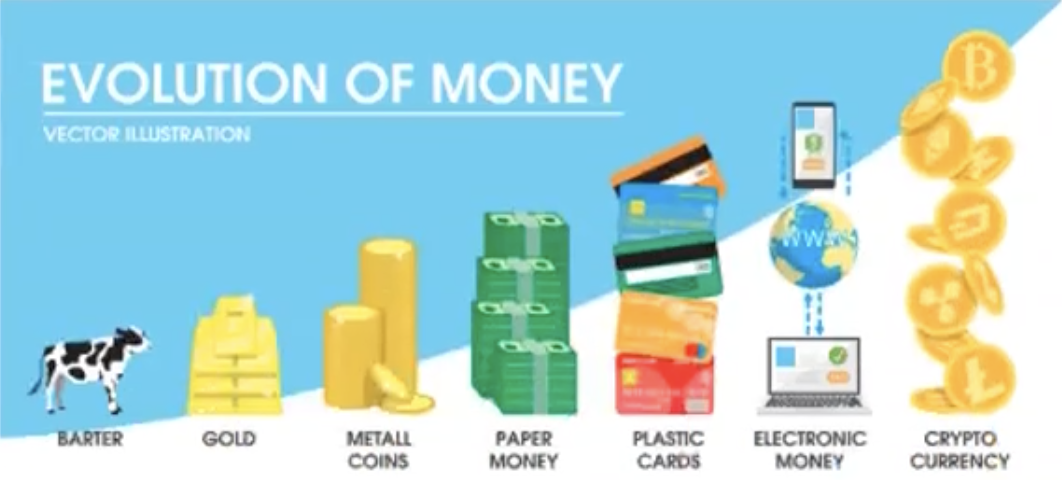
Figure 1
Bartering, a direct trade of goods and services, is the first known medium of exchange. Under the barter system, transacting parties needed to demand the goods or services each party offered to facilitate a transaction. However, a uniform structure to assign value was absent, causing the value to hinge on the quality of the good or service.
Displacing the barter system, around 600 BC, gold, silver and copper coins became the medium of exchange, standardising value and simplifying trade. The transition created a standard unit of account, enabling trade between countries. It also lowered the market entry barriers as individuals were not restrained by the goods they bartered.
By 618 AD, banknotes were the next shift, increasing international trade. Paper lacks an intrinsic value; individuals have to trust its assigned worth. Despite their transportability, banknotes lack the durability coins possess. Nonetheless, banknotes contain security features, safeguarding against counterfeiting and maintaining public confidence and credibility in the currency.
The 21st century has given rise to digital currency, in which 92% of the world’s currency is digital (“12 Facts about Technology”). People and businesses can seamlessly execute instant transactions cross-frontier. With its decentralised and efficient technology, blockchain has made money multifaceted. Cryptocurrencies are not government controlled, making it easier for people in some countries to send money to others, such as those affected by the Russia-Ukraine war.
Currently, Blockchain technology is becoming increasingly prevalent. With its decentralised and efficient technology, blockchain has made money multifaceted. Cryptocurrencies are also used in numerous developing countries. How does Blockchain impact these developing countries?
The Impact of Blockchain Technology on Developing Countries
1.7 billion individuals do not have access to banking infrastructure (The World Bank, 2018). Contributing factors are individuals lacking valid identification or financial facilities lacking the infrastructure to store money. Moreover, banks are disincentivised by high associated costs and a lack of investment guarantees to supply financial infrastructure for the unbanked.
Most unbanked individuals live in developing countries with cash-dependent economies (fig below). A high proportion of trade is informal, such as in India, where 20% of its population is unbanked (Times of India, n.d.). On the other hand, the majority has access to the internet, making cryptocurrency a seamless transaction. Banking the unbanked through Blockchain technology is crucial for developing economies.
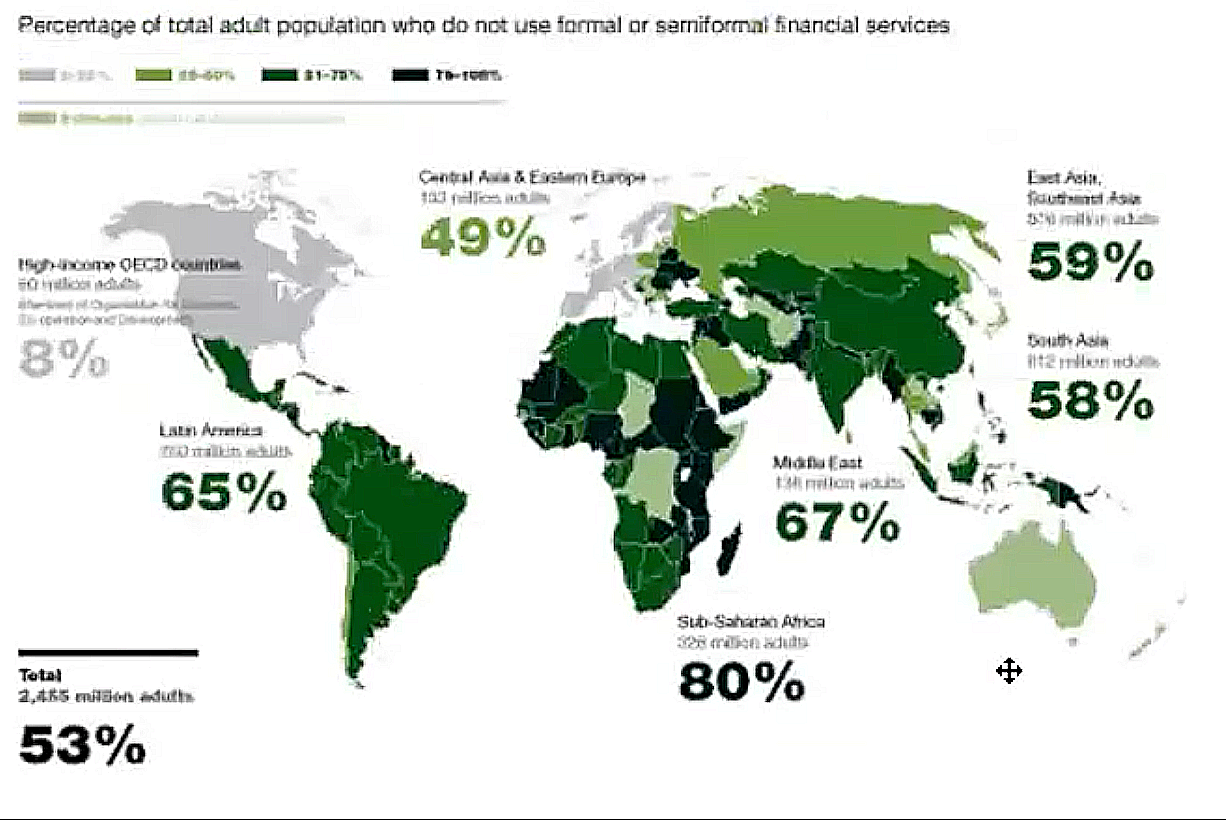
Figure 2
It aids in bringing financial inclusivity to parts of the world without economic infrastructure and transparency. For example, Figure 1.0 shows that more respondents from developing countries currently use Bitcoin (Statista, 2020).
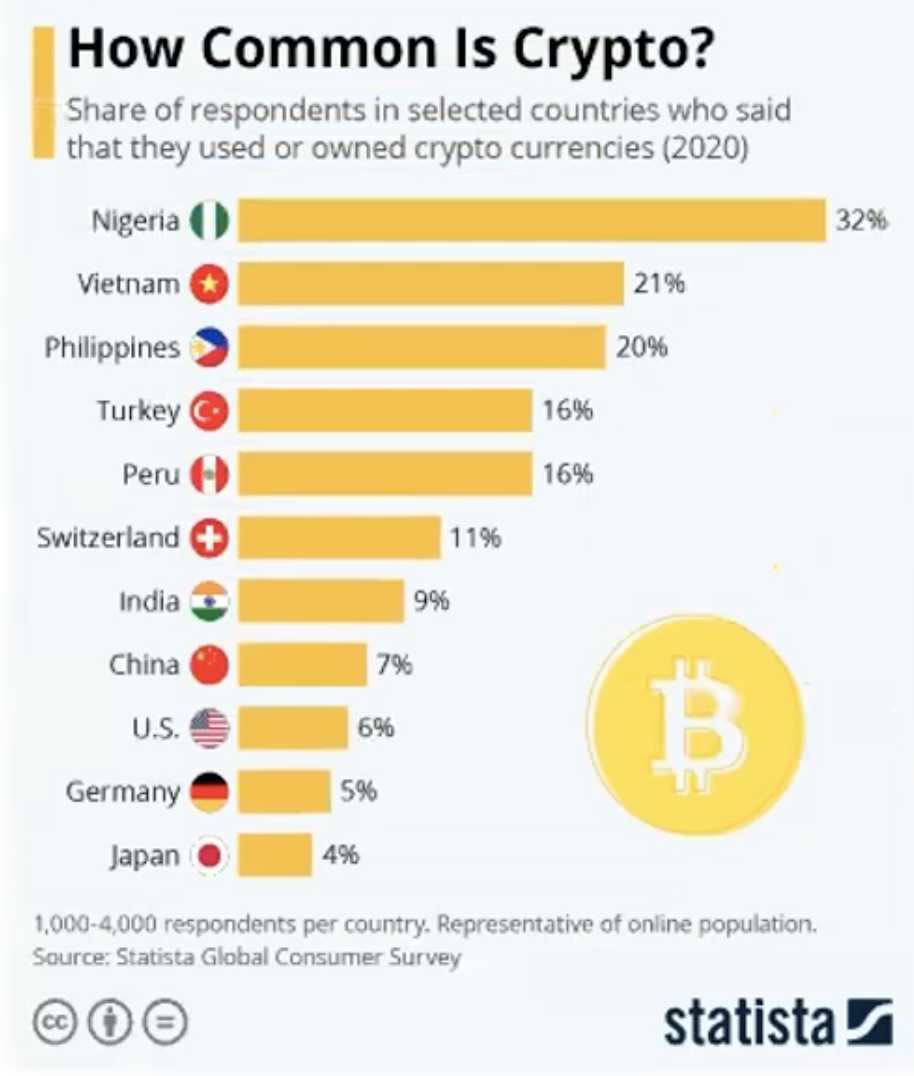
Figure 3
Due to its decentralised nature, Blockchain technology enables cryptocurrency transactions to be lower in cost than regular banks and more secure for cross-border money remittances. In addition, transactional records are validated on an irreversible digital ledger. As a result, many emerging countries are introducing their own CBDCs to streamline the financial system.
Where Do CBDCs Come into Play?
CBDCs (Central Bank Digital Currencies) are digital tokens issued by central banks and were created to transfer value digitally. While transactions on the digital ledger are traceable, established crypto currencies, such as Bitcoin and Ethereum, have taken security measures. With the use of smart contracts and hash-functions the use of crypto currencies is very secure.
Per the figure below, interest in CBDCs has grown exponentially in the last five years.
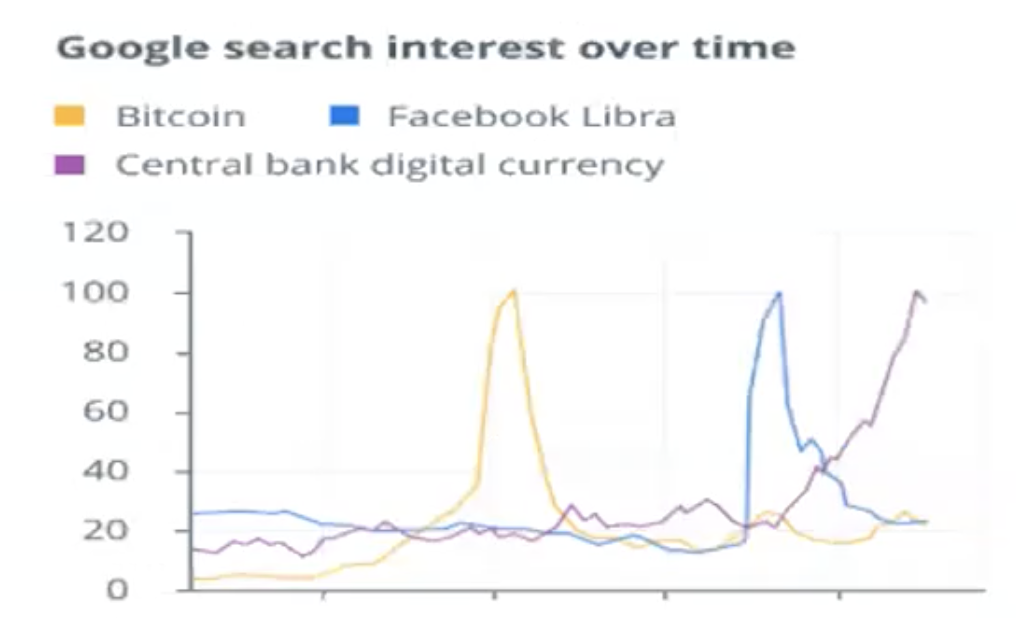
Figure 4
They enable central banks to issue fiat currency digitally. CBDCs were created to transfer value digitally. Unlike cryptocurrencies, CBDCs are centralised. While transactions on the digital ledger are traceable, established cryptocurrencies, such as Bitcoin and Ethereum, have taken security measures. For instance, Ricardian smart contracts subsume legal agreements, thus enforcing security virtually.
One main benefit of CBDCs is their environmentally-friendly nature. This is crucial as cryptocurrencies are using proof-stake rather than proof-of-work methods. This means producing and trading the currency consumes less energy – a key reason for the popularity of CBDCs: 19 of the G20 countries are developing CBDCs.
CBDCs do present significant drawbacks. They could increase the operational costs of the central bank. Additionally, commercial banks could face losses if consumers have access to retail CBDCs. CBDCs could alter the roles of the private sector and central banks, affecting monetary policies by changing the supply of reserves in the banking system. It is plausible central banks will play a role in lending, further diminishing the role of commercial banks. CBDCs will enable greater comprehensive state surveillance. The state has the right to invade users’ privacy, raising ethical concerns. Furthermore, another effect of CBDCs is the change in the perception of value.
The Perception of Value
The perception of value, particularly for Blockchain, is heavily media-influenced. This is illustrated in the figure below; the value of Bitcoin fluctuates due to changes in its perceived value. In addition, the utility gained from the use of blockchain and its endorsers has also impacted its value.
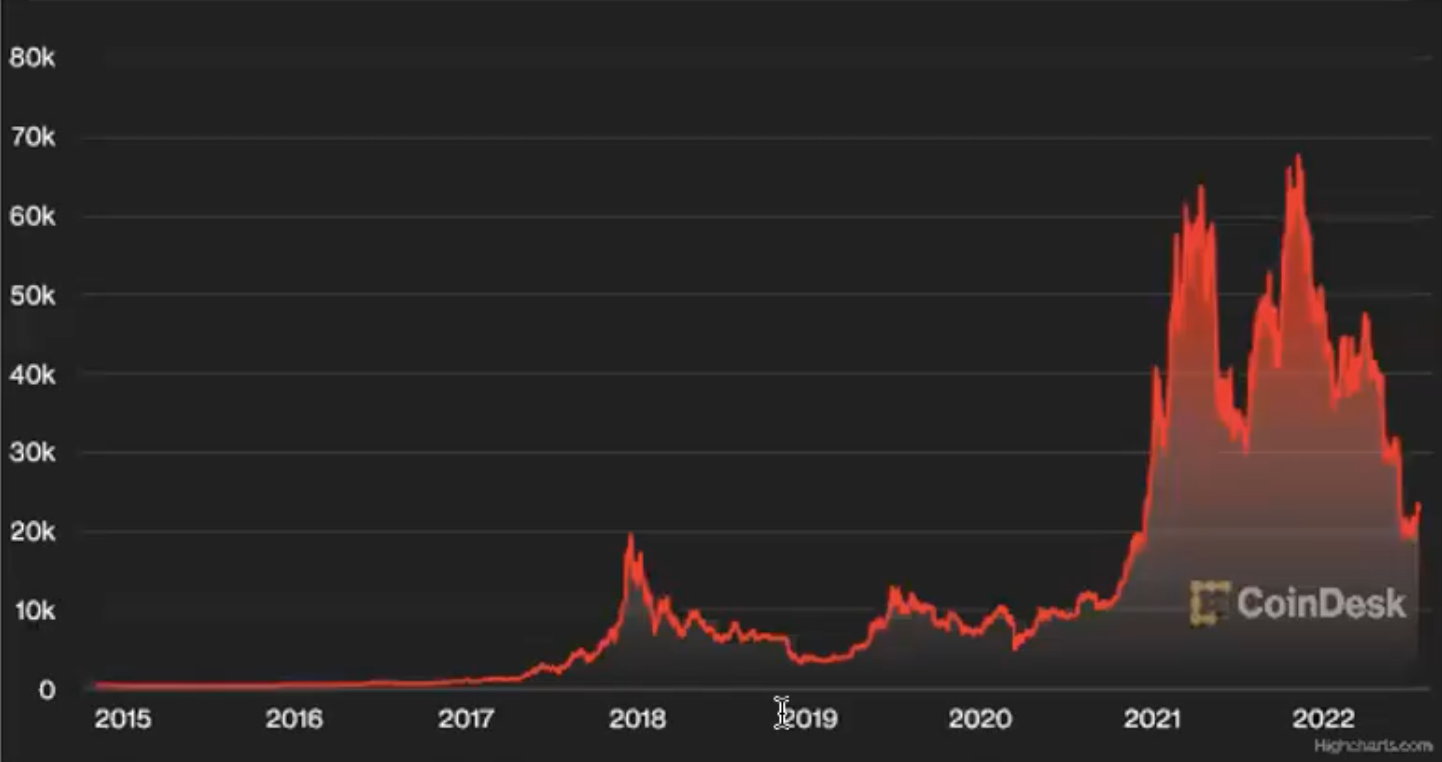
Figure 5
Blockchain has mainly become widespread due to the media. Articles and social media posts have increased awareness of Blockchain’s utility. However, due to the universal access to media and the ability to spread misinformation, there is currently no possible means of controlling the media’s influence on Blockchain’s value.
Firms’ perceived value of efficiency is evolving with Blockchain. Previously, firms dedicated scarce resources to tracking transactions. Due to Blockchain’s simplification of processes, firms can redirect their factors of production. Blockchain reduces the resources needed to track and create transactions. Thus, firms may reduce the employees overseeing financial transactions. However, this may negatively impact a country’s unemployment rate, one of the risks of blockchain technology.
SWOT Analysis
On the one hand, there are numerous benefits and opportunities due to the implementation of Blockchain technology worldwide. Blockchain’s popularity growth has been attributed to its security and transparency, revolutionising the financial technology industry. Cryptocurrencies have increased ease of access, aiding the unbanked in obtaining the financial services they require. In addition, it has improved the financial inclusivity and welfare of emerging countries’ citizens. Furthermore, distributed ledger technology and digital currencies are reshaping how firms operate, offering numerous benefits, including increased efficiency and lower transaction costs. Lastly, Cryptocurrency provides privacy by preventing essential details, such as names, from being shared on the platform.
Nevertheless, the introduction of Blockchain technology has presented its limitations and threats. Currently, mining cryptocurrencies that rely on the blockchain is environmentally unfriendly. For example, the figure below shows that bitcoin mining consumes approximately half as much electricity as the UK. This could pose a problem as climate change becomes a more significant issue in the future.
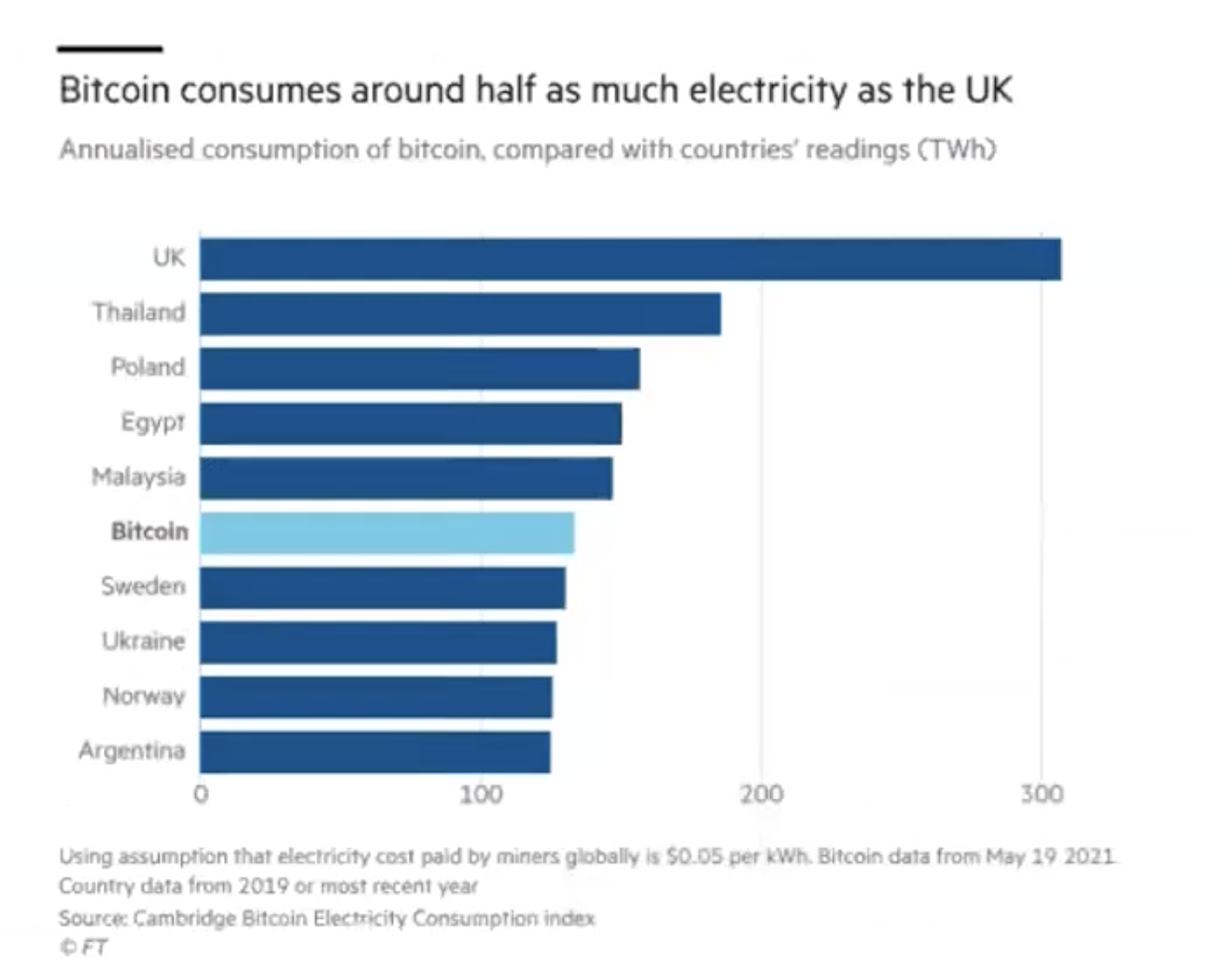
Figure 6
For example, price volatility and cybersecurity threats pose significant obstacles to the global adoption of cryptocurrency. Moreover, the volatility of cryptocurrencies is a key downside to adopting them as a global currency due to rapid value fluctuations.
Additionally, a study from the University of Technology in Sydney found that half of bitcoin transactions were associated with illegal activity (Foley et al.). Blockchain has enabled cryptocurrencies to facilitate crimes such as money laundering, trade in contraband goods, and funding of crimes like tax evasion and extortion (Blockchain When It Comes to Policing and Crime?”). Although ransom attacks on computers have existed, they were rare due to an inability to remain anonymous while collecting the victim’s money. Cryptocurrencies enabled individuals to purchase it from an exchange like Coinbase and send it to the criminal’s unknown Bitcoin address (Black).
Conclusion
Blockchain is changing our world and we cannot stop it. This essay explored the history of money and assessed the influence of blockchain technology on developing economies and the role of CBDCs globally. It also included an examination of how the perception of value affects cryptocurrencies that rely on blockchain innovation. Finally, a SWOT analysis defined the benefits and demerits of blockchain.
Blockchain technology is extremely useful and viable. It can create access to financial systems for people across the world, bringing us a step closer to complete economic globalisation. As it changes our world, we must understand its effects and learn to implement it correctly in order to make transactions more efficient. It is also imperative to understand that this technology is helping the unbanked store their money more securely and improve developing economies. While blockchain can be seen as unstable due to its price and perception volatility, it can still be beneficial for developing countries and war-stricken countries. This is because it can allow for seamless transactions in countries where accessibility to banks is not a suitable option.
To conclude, the emergence of Blockchain technology has brought about many opportunities and threats, which will continue to evolve as both money and cryptocurrency’s values continue to fluctuate amid increasing globaslisation. Blockchain has established grounds for more instantaneous, transparent and seamless transactions which have aided and improved the financial inclusivity of the unbanked in developing countries. We must, however, be aware of the environmental impact especially as it could be detrimental to our climate.
References
“12 Weird but True Facts about Technology.” The Times of India, timesofindia.indiatimes.com/12-weird-but-true-facts-about-technology/92-of-the-worlds-currency-is-digital/photostory/51422304.cms#:~:text=92%25%20of%20The%20world. Accessed 9 July 2022.
Anderson, James, and James Narus. “Business Marketing: Understand What Customers Value.” Harvard Business Review, August 1998, https://hbr.org/1998/11/business-marketing-understand-what-customers-value
Anupam, Suprita. “Decoding India’s CBDC Project – the Ambitious Plan to Launch India’s Digital Currency.” Inc42 Media, 20 Feb. 2022, https://inc42.com/features/decoding-indias-cbdc-project-the-ambitious-plan-to-launch-indias-digital-currency/.
Augustine, Evamarie. “CBDCs Explained.” Quantum Economics, 20 Dec. 2021. medium.com/quantum-economics/cbdcs-explained-f320ecbd3c88. Accessed 9 July 2022.
Beattie, Andrew. “The History of Money: From Barter to Banknotes.” Investopedia, 2019, www.investopedia.com/articles/07/roots_of_money.asp. Accessed 16 July 2022.
Black, David B. “Cryptocurrency Fuels Growth of Crime.” Forbes, 11 Mar. 2022, www.forbes.com/sites/davidblack/2022/03/11/cryptocurrency-fuels-explosive-growth-of-crime/?sh -68351660618a. Accessed 16 July 2022.
“Cryptocurrencies as a Solution for the Unbanked.” Unbanked, 2 Mar. 2021, unbanked.com/cryptocurrencies-as-a-solution-for-the-financially-unbanked/. Accessed 3 July 2022.
“Financial Inclusion on the Rise, but Gaps Remain, Global Findex Database Shows.” World Bank, 19 Apr. 2018, www.worldbank.org/en/news/press-release/2018/04/19/financial-inclusion-on-the-rise-but-gaps-remain-global-findex-database-shows. Accessed 3 July 2022.
Foley, Sean, et al. “Sex, Drugs, and Bitcoin: How Much Illegal Activity Is Financed through Cryptocurrencies?” SSRN Electronic Journal 17 Jan. 2018, https://papers.ssrn.com/sol3/papers.cfm?abstract_id=3102645. Accessed 16 July 2022.
Gesley, J. (2021). ‘New Report on Regulation of Cryptocurrency Around the World’ Published In Custodia Legis: Law Librarians of Congress. [online] blogs.loc.gov. Available at: https://blogs.loc.gov/law/2021/12/new-report-on-regulation-of-cryptocurrency-around-the-world-published
Hayes, Adam. “Blockchain Explained.” Investopedia, www.investopedia.com/terms/b/blockchain.asp#toc-pros-and-cons-of-blockchain. Accessed 2 July 2022.
“How Bitcoin Can Benefit the Unbanked.” The Guardian Nigeria News – Nigeria and World News, 2 Nov. 2021, guardian.ng/business-services/money/how-bitcoin-can-benefit-the-unbanked/. Accessed 4 July 2022.
lansiti, Marco, and Karim Lakhani. “The Truth about Blockchain.” Harvard Business Review, 6 Mar., 2018. https://hbr.org/2017/01/the-truth-about-blockchain.
“India Has Second-Largest Unbanked Population.” The Times of India, 15 July 2018, timesofindia.indiatimes.com/business/india-has-second-largest-unbanked-population-in-the-world/articleshow/64570254.cms. Accessed 16 July 2022.
“Is Blockchain Good News or Bad When It Comes to Policing and Crime?” The Police Foundation, The Police Foundation, 21 Sept. 2018, www.police-foundation.org.uk/2018/09/is-blockchain-good-news-or-bad-when-it-comes-to-policing-and-crime/. Accessed 16 July 2022.
QUIROZ-GUTIERREZ, M. (2022). Dogecoin Jumps Nearly 14% on Reports That self-proclaimed Dogefather Elon Musk May Buy Twitter. [online] Fortune. Available at: https://fortune.com/2022/04/25/dogecoin-crypto-spike-elon-musk-twitter-takeover-bid/ (Accessed 6 Jul. 2022).
Rathburn, Daniel. “Countries Developing a Central Bank Digital Currency (CBDC).” Investopedia, 11 Mar. 2022, www.investopedia.com/countries-developing-central-bank-digital-currency-cbdc-5221005. Accessed 3 July 2022.
Rhodes, Delton. “Blockchain Fraud: New Policies and Technologies to Stop Crypto Criminals.” CoinCentral, 6 Sept. 2018, coincentral.com/blockchain-fraud-stop-crypto-criminals/. Accessed 5 July 2022.
Spilka, Dmytro. “Blockchain and the Unbanked: Changes Coming to Global Finance.” Blockchain Pulse: IBM Blockchain Blog, 17 Mar. 2020, www.ibm.com/blogs/blockchain/2020/03/blockchain-and-the-unbanked-changes-coming-to-global-finance/. Accessed 3 July 2022.
Tapscott, Alex, and Don Tapscott. “How Blockchain Is Changing Finance.” Harvard Business Review, 1 Mar., 2017. https://hbr.org/2017/03/how-blockchain-is-changing-finance




